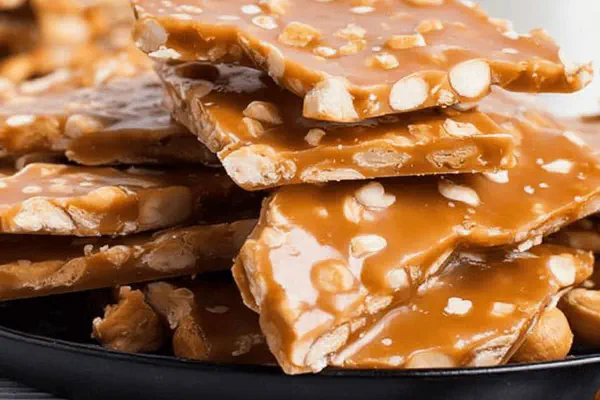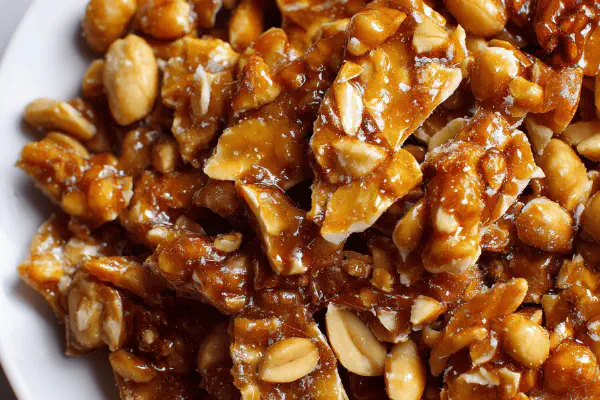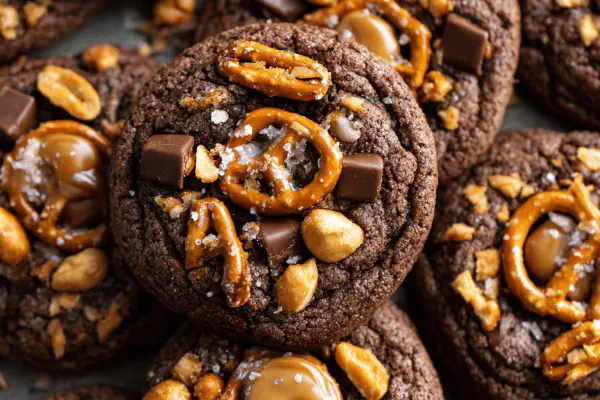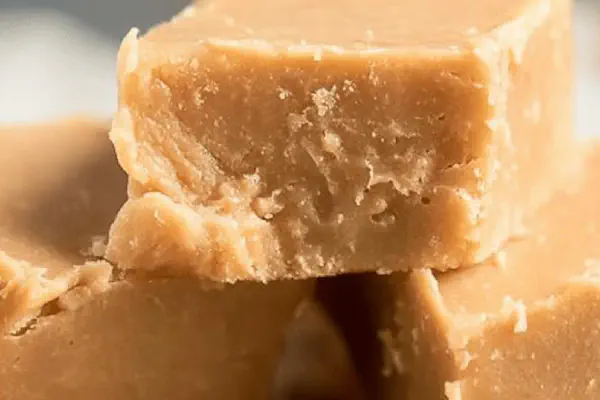Cashew Crunch Brittle

E
By Emma
Certified Culinary Professional
•
Recipe tested & approved
Sugar, butter, water, and corn syrup heated past soft crack, hitting the hard crack stage near 300°F. Baking soda added last to create that signature bubbly texture and snap. Cashews swapped in for pecans—more buttery, less common. Vanilla adds warmth. Parchment or silicone lined pan for easy, even cooling into shards. Timing tricky, bubble pop, golden tint dictate readiness more than minutes. If too dark, bitter; too light, sticky mess. Keys: no stirring early, rapid mix-ins, quick pour and spread before hardening. Classic candy making with twists in nuts and subtle heat adjustments. Blend deep caramel aroma with smoky notes, candy crack snap, and complex toasted nut flavor. Notes on stove types, candy thermometer use, and alternatives included for practical tweaks.
Prep:
3 min
Cook:
18 min
Total:
21 min
Servings:
6 servings
#candy making
#nut brittle
#American sweets
#caramel
#candy tips
Been through a gamut of nut brittles. Pecans standard but the cashew? Different—extra cream and chew. This candy calls for patience more than exact timing. You’ll see that transformation in color and bubbles before the thermometer even gets close. Skipping the stir phase early on is a must or you’ll crystallize sugars. Butter adds richness—no substitutes here unless you want flavor compromise. Replacing light corn syrup with honey once turned sticky disaster. Tried brown sugar swap, nope; too much molasses flavor. Vanilla in the end—don’t add too soon or it evaporates. Baking soda? Scary froth, but that puff changes texture from rock hard to a more forgiving crunch. Watch the pan prep—nothing worse than brittle stuck to metal, battling with icing sugar or vegetable oil. Trust the color and pop sounds for doneness, not just thermometer. For indoor cooks and weekend warriors alike—and those who’ve wrecked candy before, here’s a guide that cuts the nonsense.
Ingredients
- 1/2 cup water
- 2 cups granulated sugar
- 2/3 cup light corn syrup
- 6 tablespoons unsalted butter
- 1 teaspoon baking soda
- 1 teaspoon vanilla extract
- 1 1/2 cups raw cashews
About the ingredients
Water thins the sugar solution, delaying caramel burn. Granulated sugar essential; no substitutes—brown or powdered ruins texture. Light corn syrup stops crystallization and keeps brittle smooth; you can try golden syrup for a less processed profile but expect flavor shift. Butter—unsalted only, clarity on taste and control. Baking soda acts as leavening, making brittle porous and crunchy rather than dense; omit and it’s just hard candy. Vanilla is last minute flavor boost, not heat stable so always add off-heat. Cashews raw, toasting separately messes with timing and oil release. Instead of cashews, toasted almonds or macadamias work fine for nuts but adjust butter slightly to avoid greasiness. If no candy thermometer, test sugar by dropping a bit into cold water—snap means you’re close.
Method
- Line a large rimmed baking sheet with a silicone mat or parchment paper. Set aside.
- Pour water, sugar, corn syrup, and butter into a large heavy-bottomed pot fitted with candy thermometer. Let come to boil without stirring. No peeking until mix shifts from clear to faint amber sheen—watch closely after 12 minutes. Heat until thermometer reads about 300°F, the hard crack stage. Remove from burner immediately. On electric stoves, move pot off heat to prevent residual cooking.
- Quickly but carefully stir in baking soda, vanilla, and raw cashews. Mixture foams aggressively due to baking soda reaction. Stir just enough to combine before foam starts to settle.
- Immediately pour the bubbling toffee onto the prepared sheet. Use a heatproof spatula or offset knife to spread the mixture into an even 9×12-inch rectangle. Move fast; it begins to solidify within seconds. Aim for thin but substantial layer for crunch without breaking too easy.
- Let cool completely at room temperature. No fridge or freeze—cold snaps brittle too fast causing potential cracking mess. Once hardened, break into irregular pieces with your hands or a rolling pin inside a towel.
Cooking tips
Patience on caramelizing sugar is everything. Don’t disturb early or you crystallize the batch; it starts clear then shifts slowly amber—watch edges for darker hues first. Stirring later with baking soda generates a frothy chemical reaction creating sugar bubbles—don’t panic. Immediate pouring onto silicone or parchment to prevent melt mess and difficult cleaning. Work fast, brittle hardens from bottom up—spread with swift, confident strokes. The thin rectangles help uniform cooling and easy breakage. Never refrigerate brittle; cold shrinks sugar and causes cracking shards that stick to surfaces. Break by hand or gently tap with a heavy object wrapped in cloth to control shard size. Cleanup tip: soak pans immediately in hot water, sugar sets like cement. Watch for scorching smells, they mean too hot, burning starts fast around 310°F.
Chef's notes
- 💡 No stirring till syrup clouds. Watch for slow amber shift on edges then soft crack stage near 300 degrees Fahrenheit. Temperature readout just guide; bubble pop and color more key. Electric stovetops keep pot off heat after reach hard crack to avoid carryover cooking; gas can be quicker, watch closely.
- 💡 Add baking soda, vanilla and nuts fast; mix gently not long. Froth inflates brittle texture, creates snap and porous crunch. Stir lightly to combine. Avoid heavy stirring or foam collapse. Parchment or silicone sheet prepped beforehand critical; prevents sticky mess cleanup and easy shard breakage.
- 💡 Rapid spread once off heat. Mixture sets fast; even 9×12 rectangle with spatula or offset knife. Thin but firm, not ultra thin or brittle snaps too small. Cool completely room temp; refrigeration shrinks sugar causing cracking shards sticking everywhere. Break with hands or wrapped rolling pin for controlled shard sizes.
- 💡 Substitute raw cashews with almonds or macadamias sparingly; orange oils and butter adjust to avoid greasy feel. Corn syrup key anti-crystallization agent, but golden syrup close alternative; honey ruins texture sticky and slow to set. Butter unsalted only; salt or margarine affect clarity and texture. Brown sugar ruins brittle, molasses flavor.
- 💡 Cleanup quick soak after use. Sugar sets cement hard. Hot water essential, soak while still warm to ease residue removal. Scorch smells mean sugar burned, heat above 310 Fahrenheit fast damages batch. Watch pan surface; avoid metal trays without parchment or risk stubborn sticky brittle stuck.
Common questions
When to stir in baking soda?
Add quick after removing from heat. Mixture foams fast. Stir minimally. Too slow and mix hardens; too long breaks bubbles. Timing key for airy crisp.
Can I use nuts toasted first?
No. Raw nuts hold timing and oil release better. Toasted nuts push oil early, change cooking time and texture. Adjust butter if swapping nuts to avoid greasy brittle.
What if brittle too sticky?
Usually undercooked or not at hard crack. Check thermometer but color and sound better clues. Pour and spread faster. Skip fridge to avoid condensation. Add corn syrup prevents crystallization sticky mess.
How to store brittle?
Room temp in airtight container best. Avoid fridge/freezer, sugar shrinks and cracks. Paper towel to absorb moisture helpful in humid climates. Stack carefully to avoid shard breakage.



